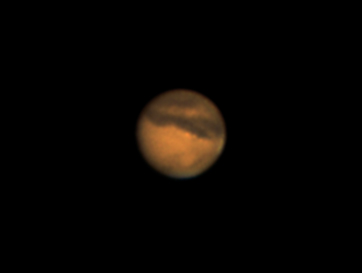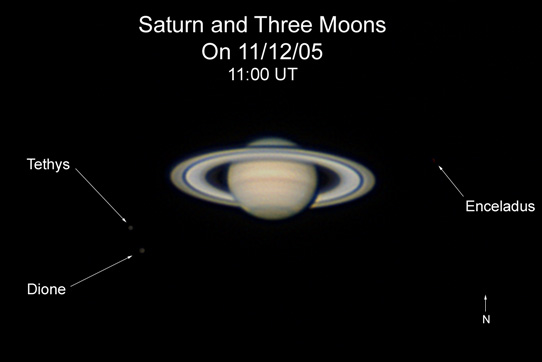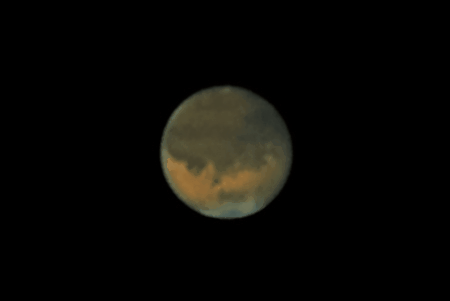
November 2005 Images
Page 1
______________________
|
It is fitting to start the month of November 2005 with an image of Mars. Since it comes to opposition on November 7th, it is being observed by many in the amateur astronomy community, yours truly included! The image below was obtained at a public star party put on by the Lafayette Natural History Museum and Planetarium. I volunteered to show Mars to the public with my webcam on my laptop at the event. The kids got a big kick out of seeing it on a computer screen enlarged much more than the visual view they were getting through the other telescopes that the planetarium staff had set up. (I had the 200% enlargement turned on in K3CCDTools.) Since this was only a demonstration, I captured a short AVI that gave me about 200 frames. Out of those, I let K3CCDTools stack 70 frames to form the image. The kids loved it! I think I gave them something they will remember for a long time to come. |
|
Mars on 11/05/05, 15:07 UT (9:07 pm CST.) C-8 2000mm, Celestron Ultima 2X Barlow, Toucam Pro webcam in "RAW" mode. K3CCDTools was used for image acquisition. This image was generated with 70 frames out of 200 total and stacked in K3CCDTools with an unsharp mask filter. Photoshop was used for additional unsharp masking, color balance adjustments and to rotate and crop. South is up. |
______________________
Mars at Opposition
11/07/05
|
The big day has finally arrived. Mars is at opposition. This means that Mars is now directly opposite of the sun from us. If you drew a line from the Sun through the Earth and kept going, you would end up at Mars. Actually, Mars reached opposition early in the morning on 11/7/05 at 2:20 AM. Mars will rise when the sun goes down and be high overhead at midnight. It will rise earlier and earlier as the month goes on, too. Now, I do not have to wake up early at some dreadful hour to image it! LoL! For the image on this night, I decided something different needed to be done. I thought about stacking my old 2x Barlow with my new one, but suddenly I had a better idea: I took the lens out of a plastic Barlow lens that came with my nephew's Meade refractor and used it as an extension tube to increase the focal length of my system! This made the image scale almost double. The image below is 100% of the original size that I captured it at. Compare it to the image further up the page, which is also at 100% scale. |
|
Mars near Opposition on 11/08/05, 5:21 UT (11/07/05, 11:21 pm CDT.) C-8, 2000mm F/10, Toucam Pro webcam in "RAW" mode on a 1.25" extension tube, Celestron Ultima 2X Barlow and 2" diagonal . K3CCDTools was used for image acquisition. This image was generated with 300 frames out of 1194 total and stacked in IRIS with wavelets and an unsharp mask filter. Photoshop was used for additional sharpening, color balance adjustments and to rotate and crop. South is up. |
______________________
Mars - Olympus Mons
Rotation Movie
|
Olympus Mons is the largest mountain in the solar system. It makes Mt. Everest look like a dwarf. LoL. It is an ancient volcano on Mars that is seen better in telescopes when Mars is at opposition. While Mars was at it's best and near opposition, I imaged it over the course of several nights. I took eleven images from these sessions and made a movie that shows Olympus Mons rotating off the face of the planet. It is the bright spot in the lower left quadrant of the planet. Since the frames were made on several different nights, the color, size and angle of the planet varied a little. But, I did my best to put them in order and line them up correctly so the movie would look half-decent. Check it out: |
|
Rotation of Mars near Opposition. Eleven frames taken on various nights from 11/7/04 to 11/12/05. C-8, 2000mm F/10, Toucam Pro webcam in "RAW" mode, Celestron Ultima 2X Barlow. K3CCDTools was used for image acquisition. Photoshop was used to layout the frames and align them and GIF Animator was used to make the animation. |
|
One of the better stills from the above animation. This particular image was taken on 11/12/05 at 3:30 UT (11/11/05 9:30 PM CST.) C-8, 2000mm F/10, Toucam Pro webcam in "RAW" mode, Celestron Ultima 2X Barlow. K3CCDTools was used for image acquisition, stacking and initial sharpening. Photoshop was used for final sharpening, noise removal and color balance. |
______________________
Saturn is Back!
Imaged on 11/12/05
|
Saturn is now rising in the east in the early morning hours and is high enough to image from about 2:00 am till sunrise. I pulled another all-nighter and imaged Mars and Saturn on Friday night, Nov 11/12th, 2005. Here is the image I generated with 800 frames from one AVI movie: |
|
Saturn early in the morning on 11/12/05. 800 frames out of 1200 acquired and stacked in K3CCDTools. C-8, 2000mm F/10, Toucam Pro webcam in "RAW" mode, Celestron Ultima 2X Barlow. Photoshop was used to do some post-processing color balance and fine tuning. |

|
A reprocessed version of the above image done in IRIS revealed 3 moons that were picked up by my Toucam Pro. A fourth moon (Mimas) was too dim and is not visible, although it was to the immediate left of the rings, above Tethys and Dione. |
______________________
Mars on 11/13/05
4:15 UT (10:15 PM CDT)
|
Here is Mars on the night of October 12th, 2005. I did some visual observations of the Red Planet early on. From those I determined when the seeing got good enough to try for another image of Mars. Unfortunately, by that time, the clouds were threatening and I had only a short imaging session because they eventually took over the whole sky. |
|
Mars on 11/13/05, 4:15 UT (11/12/05, 10:15 pm CDT.) C-8, 2000mm F/10, Toucam Pro webcam in "RAW" mode on a 1.25" extension tube, Celestron Ultima 2X Barlow and 2" diagonal . K3CCDTools was used for image acquisition. This image was generated with 300 frames out of 1194 total and stacked in K3CCDTools with an unsharp mask filter. Photoshop was used for additional sharpening, color balance adjustments and to rotate and crop. South is up. |
______________________
Martian Volcanoes on 11/14/05
4:41 UT (10:41 PM CDT)
|
Here is Mars on the night of October 13th, 2005. High wispy clouds were covering Mars, but they were so thin I was able to image through them. The seeing was better than on Saturday night. With the seeing so good, all 4 of the Tharsis Volcanoes are visible in this image. Other surface features not often seen in images from scopes under 10 inches are also visible. I have a comparison with a Calsky.com simulated image here, if you want to see how well I fared . LoL! Move your mouse over the image to display the volcano names. |
|
Mars on 11/14/05, 4:41 UT (11/13/05, 10:41 pm CDT.) C-8, 2000mm F/10, Toucam Pro webcam in "RAW" mode on a 1.25" extension tube, Celestron Ultima 2X Barlow and 2" diagonal . K3CCDTools was used for image acquisition. This image was generated with 995 frames out of 1195 total and stacked in K3CCDTools with an unsharp mask filter. Maximum Entropy deconvolution on the individual RGB layers. Photoshop was used for one additional sharpening, color balance adjustments and to rotate and crop. South is up. |
______________________
|
The month of November is already more than half over. Mars and Earth are getting further apart, so now is the time to try and get those final best images of Mars taken before it is too late. I went out on 11/17/05 and 11/18/05 and tried my luck at imaging the Red Planet again. Unfortunately, a cold front had recently passed through, so the atmosphere was unstable and the seeing was very bad on Thursday, 11/17/05. On Friday, it was not much better. Clouds were hampering my efforts at capturing a few AVI. The seeing was still low at 3/10 or so, so I just imaged anyway despite the clouds. I had to adjust the brightness and gain throughout the capture to maintain good brightness levels because of the clouds. I did not hold much hope for getting a usable image, but as luck would have it, I managed to get something after all. Here is a stack of 790 frames from the last imaging attempt on Friday night: |
|
Mars on 11/19/05, 3:55 UT (11/18/05, 9:55 pm CST.) C-8 2000mm, Celestron Ultima 2X Barlow, Toucam Pro webcam in "RAW" mode. K3CCDTools was used for image acquisition. This image was generated with 790 frames out of 1194 total and stacked in K3CCDTools with an unsharp mask filter. Photoshop was used for additional unsharp masking, color balance adjustments and to rotate and crop. South is up. |
______________________
|
Two decent images of Mars taken about 30 minutes apart were obtained on the night of November 21, 2005. The seeing was mediocre, about 5/10 I would guess. Mars is starting to get smaller now that we are getting towards the end of November. It is more noticeable now. The images are displayed at 100% of their imaged size of my telescope and barlow arrangement. If you click on them, I have a 2x enlargement that you can see. |
|
Mars on 11/22/05, at 4:15 UT (11/21/05, 10:15 pm CST) and at 4:45 UT (11/21/05, 10:45 CST.) C-8 2000mm, Celestron Ultima 2X Barlow, Toucam Pro webcam in "RAW" mode. K3CCDTools was used for image acquisition. Stacks of 385 and 683 frames out of 900 total were used to create these images. Stacked and processed in K3CCDTools with an unsharp mask filter. Photoshop was used for additional unsharp masking, color balance adjustments and to rotate and crop. South is up. |
______________________
|
For Thanksgiving Day, I went to my parent's home and ate a holiday feast with them and some of my other relatives. My brother-in-law and his son was there and asked if he could come to my house later to check out my telescope and show him and his son some stuff. When they got there, I was ready. However, the clouds were hampering the view of the stars. Fortunately, ole' Mars was shining right through the clouds. It really was the only thing to look at for the time being. So we did. Not much details that I could see at that time - the seeing was bad because Mars was still too low in the sky. After visually observing it, they wanted to see what it looked like on my computer with the webcam. I fired it up and we looked at it on the screen a while. Then, I showed them how I image. I did 2 short captures and stacked maybe 100 frames each to show them how it works. I tried another longer capture. It showed that things were getting better and I might be able to obtain a pretty good image if I tried harder. The demo I was doing turned into a real imaging session. The seeing just got better and better, so I was seriously trying to get the best image possible. In all, I did ten captures and generated about 6 images. Out of those here is the best one in 2 different color schemes then a blend of the two images: |
|
Mars on 11/25/05, at 4:38 UT (11/24/05, 10:38 pm CST.) C-8 2000mm F/10, Celestron Ultima 2X Barlow, Toucam Pro webcam in "RAW" mode on an extension tube. K3CCDTools was used for image acquisition. Image 1 is 500 frames out of 1194 total, stacked and processed in IRIS with an unsharp mask filter and wavelets. Image 2 is 300 frames out of 1194 total, stacked and processed in K3CCDTools with an unsharp mask filter. Image 3 is a 50/50 blend of the two images. Photoshop was used for additional unsharp masking, color balance adjustments and to rotate and crop. South is up. |

|
Mars in motion on 11/25/05, from 2:40 UT to 4:40 UT (11/24/05, 8:40 pm CST to 10:40 pm CST.) 6 Images taken with a C-8 2000mm F/10, Celestron Ultima 2X Barlow, Toucam Pro webcam in "RAW" mode on an extension tube. K3CCDTools was used for image acquisition. Stacked and processed in K3CCDTools with an unsharp mask filter. Photoshop was used for additional unsharp masking, color balance adjustments, rotate, crop and assemble animation frames. South is up. |
______________________
The Veil Nebula on 11/29/05
|
The way this page looks now, the month of November 2005 could be called the month of Mars. Since I gave the Red One plenty of exposure already, here is something different to end the month. I present my first successful try at imaging the Veil Nebula: |
|
The Eastern Veil Nebula on 11/29/05. 120mm F/5 refractor, Canon Digital Rebel, Baader Fringe-Killer and Lumicon Deep Sky filters. Five, 300 second sub-images at 1600 ISO stacked in IRIS with dark, flat, bias calibration and DDP. Photoshop was used for levels, color balance adjustments and to rotate and crop. |
|
The Western Veil Nebula on 11/30/05. 120mm F/5 refractor, Canon Digital Rebel, Baader Fringe-Killer and Lumicon Deep Sky filters. Six, 300 second sub-images at 1600 ISO stacked in IRIS with dark, flat, bias calibration and DDP. Photoshop was used for levels, color balance adjustments and to rotate and crop. |
All Images Copyright © 2005 Mike Broussard.
All rights reserved.
To send comments or for more information, please email me at
mike@synergyitg.com.
Visitors since November 7, 2005